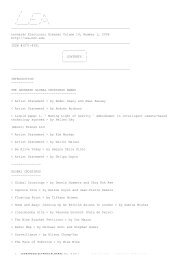Leonardo Electronic Almanac / Volume 13, No. 4 / April
Leonardo Electronic Almanac / Volume 13, No. 4 / April
Leonardo Electronic Almanac / Volume 13, No. 4 / April
Create successful ePaper yourself
Turn your PDF publications into a flip-book with our unique Google optimized e-Paper software.
ABSTRACT<br />
This article describes the digital artwork *Timeline [Who<br />
writes the history?]* by Petri Raappana. The work is a reaction<br />
to the ways of the media today with the dominating media<br />
conglomerates and attempts to promote alternative media. The<br />
article addresses questions concerning economic gains, media<br />
reform, and the role of the Internet.<br />
_____________________________<br />
INTRODUCTION<br />
*Timeline [Who writes the history?]* was created by Petri<br />
Raappana. It was shown for the first time on the art website<br />
http://www.artnode.org in 2004.<br />
The work is a reaction to the ways the media work today. It can<br />
be claimed that mainstream media are increasing in power and<br />
decreasing in quality, all of which can potentially be fatal for<br />
democracy. The deficient coverage of the mainstream media is<br />
being countered by alternative media that, however, are not as<br />
well known and do not have the recognition and familiarity of<br />
the mainstream media.<br />
*Timeline [Who writes the history?]* aims at being more than<br />
just an artistic comment on society and functioning as an<br />
internet community for the gathering of links to alternative<br />
news media.<br />
THE STRUCTURE AND THE PRINCIPAL IDEA<br />
The work consists of a Shockwave file and a database. The<br />
Shockwave file starts out with a timeline that mimics the<br />
timeline in video editing software. On the timeline are logos<br />
from the mainstream news media. By moving the timelines curser<br />
the logos move horizontally back and forth in unison. If the<br />
timeline is stretched, a ‘swarm’ of logos from alternative news<br />
media shows up moving vertically across the timeline. If the<br />
user clicks on one of these, the chosen site opens in an<br />
external window. The user can also click his or her way into an<br />
“icon maker”, where an icon can be designed. When the user<br />
starts creating icons, a question mark appears next to the icon<br />
maker. When clicking on it a new window appears with the<br />
question “Who writes the history?” and a form appears where the<br />
user can add an alternative news media (URL, description and<br />
category). The user can also view the list of links provided by<br />
others. When the user returns to the icon maker and clicks the<br />
button ‘OK’, the provided link is added to the swarm. The icons<br />
themselves are not saved; their function is merely symbolic. The<br />
link will stay on the list though.<br />
The swarm is a metaphor for a number of different players who<br />
together are creating a (hi)story. The movement of the swarm of<br />
alternative news media also gives the timeline a static and<br />
uniform look. The swarm consists of a number of sites. The user<br />
can thus participate with a subjective contribution to the<br />
writing of history.<br />
BACKGROUND<br />
Through an extensive selection of news media on the Internet,<br />
we have the possibility to follow what goes on in the world from<br />
our computers. Most of us will click onto the well known news<br />
APRIL 2005 VOL <strong>13</strong> NO 4 LEONARDOELECTRONICALMANAC 40



